The Porsche 911 Carrera 996 Buyers Guide
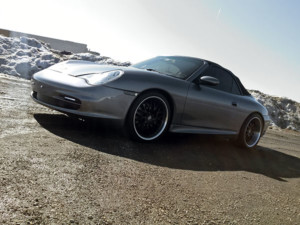 Thinking of buying a Porsche 911 Carrera 996? Our Porsche 911 996 buyers guide highlights the potential mechanical issues and can help you successfully find a solid Porsche 911 996.
Thinking of buying a Porsche 911 Carrera 996? Our Porsche 911 996 buyers guide highlights the potential mechanical issues and can help you successfully find a solid Porsche 911 996.
Classic in the making? If you’re considering buying an early 911 Carrera 996, you’ll read more horror stories than articles about heartwarming Sunday afternoon drives. The original 911 Carrera 996 is more than twenty years old and is now viewed by Porsche in the classic vehicle category. The early 996 cars are now extremely affordable and can be fun to own. However, many people are scared off by reading the hyped technical problems, so prices are low, even for good examples.
We think the Porsche 911 996 has been beaten up and under sold. Finding the right car is never simple, but with some luck and armed with the right information, you can pick up a bargain. 20-year-old cars with reasonable mileage are available for less than a small percentage of what they cost originally!
How Do You Tell A Good Porsche 911 996 From A Bad One?
Our guide to buying a used 911 996 will help you find the bargain and avoid the bad investment. There’s no fluff or niceties here – there are plenty of resources online that bash on about horse power, cosmetic variants, historical significance and the niceties of the 911 Carrera 996. All well and good, but how to do tell a good mechanical 996 from a bad one? What are the potential pitfalls? What known problems exist and how do you avoid them? We have the answers you need.
We concentrate on the technical things that might cost you money later, if you weren’t aware of them prior to buying the car. There are risks if you’re not cautious, but with some insights and careful shopping, there are bargains to be had.
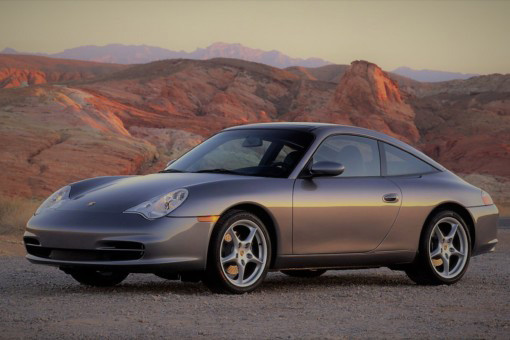
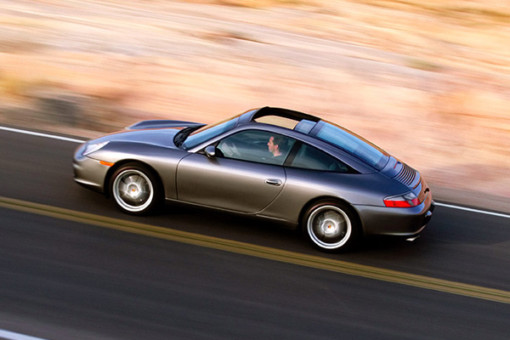
What Do We Know About the 911 Carrera 996 So Far?
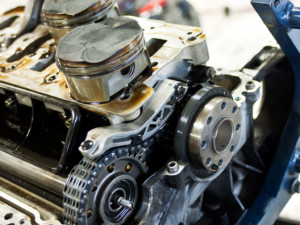 Back in the nineties, with growing emission requirements being placed on engine manufacturers, Porsche was forced to move the 911 from the 1940’s air cooled technology to a water cooled, efficient and emission compliant engine. The result was the 911 996 with its M96 flat 6 engine.
Back in the nineties, with growing emission requirements being placed on engine manufacturers, Porsche was forced to move the 911 from the 1940’s air cooled technology to a water cooled, efficient and emission compliant engine. The result was the 911 996 with its M96 flat 6 engine.
The 911 996 was such a departure from the original air-cooled technology that is caused a major division in 911 expertise that exists right up to today. The 996 was nothing like the norm Porsche techs were used to – like switching from right hand drive, to left hand drive. This is part of the reason why the new cars came in for so much criticism and misunderstanding. To this day, there is a distinct difference between an air-cooled 911 and a water-cooled 911 Porsche expert.
911 996 – First of The New Breed
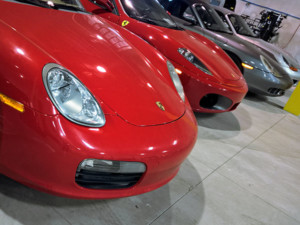 Originally, a 3.4L flat 6 M96 engine was fitted to the new 996 Carrera in 1998. Subsequently, the engine was revised in a number of ways and improved upon to be a 3.6L, before reaching the end of its production by late 2005. Porsche produced various flavors of the 996 Carrera – cabriolet, 4wd, S etc. all of which used an M96 engine. Please note, the Turbo, GT2 and GT3 versions of the 996 are exempt from this discussion as they use entirely different engines.
Originally, a 3.4L flat 6 M96 engine was fitted to the new 996 Carrera in 1998. Subsequently, the engine was revised in a number of ways and improved upon to be a 3.6L, before reaching the end of its production by late 2005. Porsche produced various flavors of the 996 Carrera – cabriolet, 4wd, S etc. all of which used an M96 engine. Please note, the Turbo, GT2 and GT3 versions of the 996 are exempt from this discussion as they use entirely different engines.
The first-generation Porsche 911 Carrera 996 is now more than 20 years old. The 996 has been driven, raced, broken, dissembled and put back together again many times. As a result, there’s extensive knowledge available of the common mechanical problems with these cars. Therefore, it should be possible to sort the good used 996 from the bad. Thankfully, the 996 Carrera is generally reliable and has aged gracefully. Many of the cars available now, have already completed the work needed to address the known issues.
Will the Porsche 911 996 Appreciate in Value?
Why not? Everything else has! There was a time, not too long ago, when the last air-cooled cars (993 chassis) were cheap to buy. Now it’s easier to find rocking horse poop than a low cost 993! So, is this possible with the 996?
It’s certainly true for the 996 Turbo, GT2 and GT3. Prices on these models have sprung up and continue to rise. Naturally, these models do not utilize the M96 engine fitted to the standard Carrera. It’s the M96 engine that seems to develop the majority of the problems and routinely receives the critical press. A rising tide floats all boats, so eventually the original 996 will have a classic appeal and should appreciate in value – the question is how long a wait?
Will the 911 996 be a Classic?
Why not? Looking out into the future, dramatic change is nearly upon us. With the change to all electric cars, the 996 will be the first of the last dying breed. Porsche switched engine production to all turbo for the later 991 cars, so only a relatively short window of normally aspirated flat 6 engines exists. The 996 is the first version of that era. When you see cars from the 70’s you know were junk at the time making big money in auctions, you know the 996 will definitely become a modern classic. One just has to be patient. Buy an original, keep it original and sit back and wait. How long is a different question!
Spare Parts and Repairs
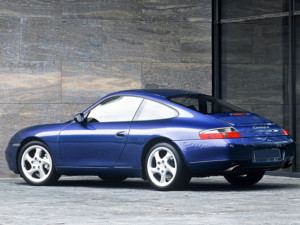 The 911 Carrera 996 is easy to upgrade from both a performance or cosmetic stand point. Many original parts were revised but were reused on the later chassis such as the 997. Most are readily available directly from Porsche and a healthy used parts market exists to fill the gaps. There are plenty of third-party parts vendors online that can offer parts at lower cost than Porsche directly. There is also a good deal of experience and expertise in independent Porsche repair shops to help make the maintenance of your used 911 Carrera 996 cost effective.
The 911 Carrera 996 is easy to upgrade from both a performance or cosmetic stand point. Many original parts were revised but were reused on the later chassis such as the 997. Most are readily available directly from Porsche and a healthy used parts market exists to fill the gaps. There are plenty of third-party parts vendors online that can offer parts at lower cost than Porsche directly. There is also a good deal of experience and expertise in independent Porsche repair shops to help make the maintenance of your used 911 Carrera 996 cost effective.
Maintenance Costs on the Porsche 911 Carrera 996
You’re buying a Porsche, so don’t compare running costs to a small domestic hatchback! Yes, parts and some labor costs will be higher than a typical American or Japanese vehicle. However, save for a few notable items discussed below, the 911 Carrera 996 is solid and reliable.
You’re going to pay a little more for an oil change and standard maintenance items, however, don’t try to cheap these. It’s really important to have the car inspected and serviced by a professional with genuine Porsche expertise. A good mechanical understanding of these cars can help identify issues early and save you money in the long term. See our guide to Porsche repair shops for your local expert or contact us and we’ll make a recommendation for you.
Porsche 911 996 Maintenance Schedule
It’s important to understand where the 996 you’re considering buying falls within it’s recommended maintenance schedule. Maintenance schedules are based on mileage and elapsed time. With an aging 996, time elapsed is likely to be the most important consideration. Compare the known maintenance history of the 996 with our recommended maintenance schedules. This should enable you to better understand the asking price, the near future maintenance requirements of the car and perhaps help identify a well maintained 996 from a neglected one.
Buying a 20 year old car and not clearly understanding the major maintenance items that should have already been completed or are coming due soon, is not the smartest thing you can do!
Pre-Purchase Inspection
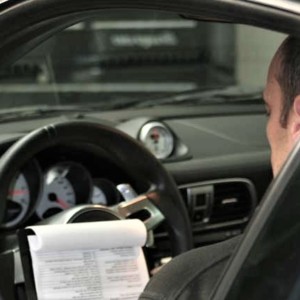
The first step, once you’ve identified a 996 candidate, is to get a thorough inspection by a local Porsche expert. The pre-purchase inspection is designed to identify mechanical problems that may not be clearly evident at first glance. In our buyer guide below, we’ve extensively highlighted those potential issues to be on the look out for. Getting a repair history on the car, if available, is helpful and will instantly identify or eliminate potential problem areas.
The number of owners doesn’t necessarily matter with a Porsche – the work and records performed do. Many owners are enthusiasts and will keep all the invoices from service or repairs performed.
If a seller wont let you inspect the car, walk away.
Consider who is selling the car. For a private sale you need to know why the vehicle is for sale. If you’re buying from a used car dealer, do your research to learn where the dealer got the car. If it’s a dealer that specializes in Porsche, well and good. However, if the dealer’s bread and butter is low cost mini vans, you need to do some serious thinking. Who trades their Porsche for a cheap mini van? The owner that has a serious engine problem and knows the mini van dealer wont find it?
Mileage and Service History
On cars approaching 20 years old, higher mileage is not necessarily a bad thing. In fact, a 996 Carrera that has been well used, could be in a better condition than one that has an attractively low mileage reading. Low mileage cars can have hidden issues.
You’ll want to take a good look through any documented service history available. A clear pattern of servicing on higher mileage cars is essential. On the lower mileage cars, timed intervals between service is the key thing to look for.
Low Mileage Garage Queen – Not So Fast!
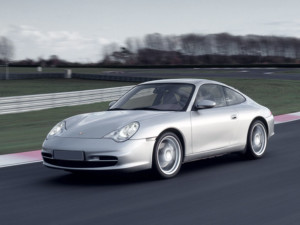 It’s always great to find a low mileage car, however, the low miles can present a different set of challenges to cars that are designed for 10K miles per year.
It’s always great to find a low mileage car, however, the low miles can present a different set of challenges to cars that are designed for 10K miles per year.
Low mile examples often miss their regular service intervals. This can cause time related degradation of the service items to be overlooked. Despite a lack of mileage, wear and tear will take place in fluids, tires, brakes, clutch surfaces and oil seals. Look to see when the last time the spark plugs were changed – 10 years is the limit regardless of mileage. The brake fluid should be flushed every 2 or 3 years. Check the DOT on the tires – lots of tread doesn’t mean they’re healthy. See more examples below.
Clearly, low mileage cars attract extra money for the purchase, but make sure you plan additional budget to catch up service work after you purchase the car.
What’s the 996 Like to Live With?
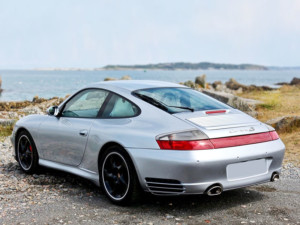 The Porsche 911 Carrera 996 has been seriously beaten up and downplayed by anyone ready to jump on the “we hate water-cooled” 911 band wagon. Yes, there are known problems, some of which can be catastrophic. However, there are thousands of 996 cars that haven’t had issues and have been well taken care of.
The Porsche 911 Carrera 996 has been seriously beaten up and downplayed by anyone ready to jump on the “we hate water-cooled” 911 band wagon. Yes, there are known problems, some of which can be catastrophic. However, there are thousands of 996 cars that haven’t had issues and have been well taken care of.
All generations of the 996 are pretty easy to drive, park and have fun in. The ride quality and handling improved through the versions, but even the original 996 is bags of fun to drive. The early version is somewhat under powered and the auto transmission is sluggish. Later versions, especially the 3.6L S, certainly have a bit more zip about them.
Original versions have plastic interior parts that can easily become discolored due to wear and tear. The HVAC digital screen is prone to losing parts of digits, which leaves you wondering just what setting you really are looking at. However, there is a healthy used parts market that can solve some of those problems easily and cost effectively. Generally, the interior is well laid out and practical. The later versions have better styled interiors than the original, however, the inside is definitely more focused on practicality as opposed to luxury.
If you buy a manual transmission car, the biggest change you can make to the livability of the car, is to install a short throw shifter. The distance between gears on the manual trans 996 is not that different from a bus! A short shifter improves the feel of the car tremendously and reduces the likelihood of missing a gear during the long travel from first to second for example.
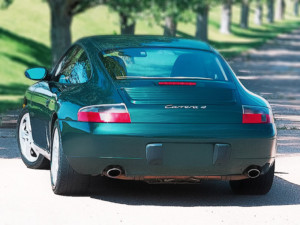 The 996 has large N rated tires. If the car you buy has 19-inch rims, you’ll be looking at more than $1k for a set of 4 tires. The rear tires will wear quicker than the fronts on the 996 due to suspension setup. It’s really important to stay on top of vehicle alignment – any loss of alignment on the rear of the 996 will eat the inner shoulder of the rear tire rapidly. This is difficult to see because it’s so far under the car, but check it regularly or you’ll be buying rear tires way more often than you expect.
The 996 has large N rated tires. If the car you buy has 19-inch rims, you’ll be looking at more than $1k for a set of 4 tires. The rear tires will wear quicker than the fronts on the 996 due to suspension setup. It’s really important to stay on top of vehicle alignment – any loss of alignment on the rear of the 996 will eat the inner shoulder of the rear tire rapidly. This is difficult to see because it’s so far under the car, but check it regularly or you’ll be buying rear tires way more often than you expect.
If your ownership plans include heading out for a track day (HPDE), then the 996 can be a lot of fun. On track, the car is easy to drive quickly, right up to the point where it will swap ends on you! Getting the most out of the 996 on track involves learning where the end swapping point is and what to do when it comes up. At this point, the best thing to do is give it more gas – which happens to be the opposite of what your life saving instincts tell you! Really pushing a 996 to the limit on track requires skill and a large set of gentleman’s attachments!
What Porsche 911 996 Would We Buy?
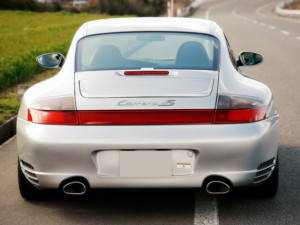 The 996 is not really a choice for practical everyday Porsche motoring. The early 911 996 is definitely more of a weekend joy ride car than a pleasant commute to the office. Later cars definitely improved on that and the revised versions after 2002 also made every day use more of a reality.
The 996 is not really a choice for practical everyday Porsche motoring. The early 911 996 is definitely more of a weekend joy ride car than a pleasant commute to the office. Later cars definitely improved on that and the revised versions after 2002 also made every day use more of a reality.
The most desirable cars are the wide-body S models manufactured after 2002. The big hips on the rear make the whole car look more aggressive and share looks with the turbo version. These are harder to find and definitely command a premium price. The later M96 engine is an improvement on the original version but still has potential issues.
The 996 911 is still making good money. Plenty of cars for sale have none of the preventative work completed. Finding a lower mileage car with good service history and work, like the IMS retrofit, having been completed, is probably the best value. However, the problems with the 996 are so well known, that a bargain basement car with higher mileage could still be a worthwhile investment, provided you are prepared to spend a little money straightening out the known issues. Don’t buy an early automatic transmission 996! The early auto version with a 3.4L engine is just plain dull and not worth the money being asked.
The most important thing to do when you shop for a 996 is to have a good relationship with an independent Porsche specialist. The real mechanical expertise gained on these cars is with the independent mechanic and not at the dealerships.
So, if you’re in the market for buying a used Porsche 996 what should you be paying attention to before you commit to buy?
Potential Mechanical Issues – What To Be On The Look Out For?
IMS Bearing – 996 Cars Up to 2005
 The M96 range of Porsche engines fitted to the 911 up to 2005, had a catastrophic engine failure associated with the intermediate shaft bearing or IMS. At the end of the intermediate shaft connecting both ends of the timing chain mechanisms, a low cost, self-lubricated ball bearing style bearing was installed – think of it like a wheel bearing. Like wheel bearings, the IMS Bearing life is limited and it can come apart causing significant damage around the engine.
The M96 range of Porsche engines fitted to the 911 up to 2005, had a catastrophic engine failure associated with the intermediate shaft bearing or IMS. At the end of the intermediate shaft connecting both ends of the timing chain mechanisms, a low cost, self-lubricated ball bearing style bearing was installed – think of it like a wheel bearing. Like wheel bearings, the IMS Bearing life is limited and it can come apart causing significant damage around the engine.
Much hype has been associated with this potential failure by people who have to gain from it, yet the anecdotal evidence shows less than 5% of the bearings fail. Porsche shipped approx. 77,000 vehicles to the USA that could have a bad IMS bearing. Even the most enthusiastic counting of IMS failures produces a total of around 3500 or less than 5%. This means there are more than 73,000 vehicles that haven’t had the problem yet or have been retrofit with a newer bearing.
The M96 engine cars built up to 2000 are less susceptible to the failure than the later ones. The early cars were fitted with a dual row bearing that was more reliable then the later single row bearing fitted to the M96 engine after 2000.
Failure is expensive and usually results in engine replacement. Most diligent owners opted to preempt the failure and replace the Porsche single row bearing with an LN dual row version. Cars that have had the IMS bearing replaced have a higher value than ones that haven’t. So, replacing the bearing usually brings not only peace of mind, but a financial return when you sell the car.
If the bearing has been replaced, there will be a sticker and serial number of the bearing in the engine lid. All the bearings are serial numbered and recorded with LN Engineering. Don’t panic if the bearing hasn’t been replaced – reduce the cost of the car in negotiation and allow about $3K for doing the work. Again, despite the hype, less than 5% fail – all you need do is find a local independent Porsche repair shop that can retrofit the IMS bearing for you.
Fault Codes and Over-Revs
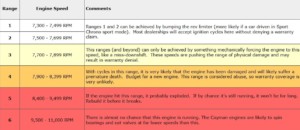 Before buying any car, it is essential to know when the last time the system fault codes were cleared and check the status of the emission monitors. It’s not difficult for a seller to clear the faults just before you arrive for a test drive. Clearing the engine faults also resets the emissions system monitors to a state of “not ready.” Emission readiness tests often occur over multiple drive cycles. So, after a reset, emission faults may not return for a significant number of miles.
Before buying any car, it is essential to know when the last time the system fault codes were cleared and check the status of the emission monitors. It’s not difficult for a seller to clear the faults just before you arrive for a test drive. Clearing the engine faults also resets the emissions system monitors to a state of “not ready.” Emission readiness tests often occur over multiple drive cycles. So, after a reset, emission faults may not return for a significant number of miles.
How Hard Has The Car Been Driven?
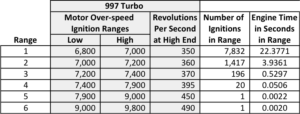 Taking the engine to the red line for RPM is a good thing, but going over the red line obviously can cause damage. A gear change at red line will actually cause the revs to increase slightly momentarily – nothing bad here. But, if you select the wrong gear, the engine revs to go way over the red line. This is the famous “miss-shift” that has caused many engine explosions.
Taking the engine to the red line for RPM is a good thing, but going over the red line obviously can cause damage. A gear change at red line will actually cause the revs to increase slightly momentarily – nothing bad here. But, if you select the wrong gear, the engine revs to go way over the red line. This is the famous “miss-shift” that has caused many engine explosions.
Thankfully, Porsche engine management records many things – one of the most significant is an over-rev situation. Data is permanently stored within the ECU showing running hours and when engine events have occurred. There are six levels of over-revs recorded ranging from the engine being red-lined through to what would be a potentially catastrophically high RPM event. Events in the first category suggests the car has been properly exercised, but events in the higher categories could be hiding a potential life shortening engine situation.
Many Porsche owners like to go to track days. On the track, gear changes will occur right around the rpm maximum red line. These events will be recorded if they reach the lower levels of the over rev counter. Multiple recorded events in the lower over-rev categories could be a sign of how much track time the car has experienced.
This is an important step and definitely contributes to a solid opinion as to how well the car has been treated in its lifetime.
Overheating – Cracked Cylinder Liners
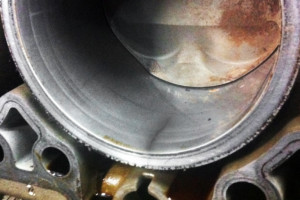 Each cylinder bore in the engine case half of the 996 M96, is lined with a one-piece sleeve or liner. The engines fitted in the 996 Carrera are prone to cracks in these liners.
Each cylinder bore in the engine case half of the 996 M96, is lined with a one-piece sleeve or liner. The engines fitted in the 996 Carrera are prone to cracks in these liners.
Results from a crack vary, but typically the most common is coolant loss with subsequent engine overheating. Sometimes, a crack in the cylinder liner can take a considerable amount of running time to fully open and cause problems. What can you do to find out?
First, note the coolant level when the engine is cold. Take your time here – you want to drive the car for 30 mins. After driving the car, let it sit and idle for a while. The front radiator fans should come on and the engine should maintain a steady temp. If the engine continues to warm and will eventually overheat, walk away.
Assuming the engine temp is OK, turn off and take a look at the coolant level – it should have risen and be falling back toward the cold level. If the level has gone down or is still at the cold level, there could be a small coolant loss through a cracked liner. The trained nose of a Porsche repair shop can smell coolant from the exhaust when the engine is running.
Note, this isn’t a definitive test because you could be loosing coolant through an external system leak. However, any loss of coolant after a drive cycle should be thoroughly investigated to ensure it’s not a cracked liner.
Cylinder Scoring
For this exercise you’ll need to lift the car and have a listen from below while the engine is running. You might need a repair shop to do that for you. You should hear the M96 engine in a 996 Carrera make a consistent ticking sound.
Much of this sound is the proximity of your ear to the valve train and the exhaust headers. However, there is a distinctly different sound that identifies with a particular issue that you don’t want to hear.
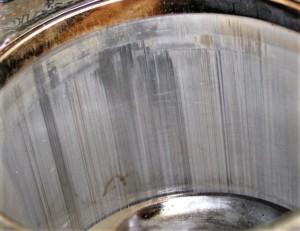 These engines are famed for cylinder scoring – deep gouges in the cylinder liner, usually associated with a knocking noise and eventually catastrophic engine failure. The root cause of this issue is open to discussion, however, wear in the piston rings and liners causes the piston to wobble. The wobble occurs at the bottom of the stroke and results in the piston skirt dragging against the cylinder wall, thereby scoring the liner.
These engines are famed for cylinder scoring – deep gouges in the cylinder liner, usually associated with a knocking noise and eventually catastrophic engine failure. The root cause of this issue is open to discussion, however, wear in the piston rings and liners causes the piston to wobble. The wobble occurs at the bottom of the stroke and results in the piston skirt dragging against the cylinder wall, thereby scoring the liner.
The sound your listening for is not a tick: it’s a rhythmic knock and usually shows up first on the passenger bank of the flat 6 engines – although, it can appear on any cylinder. The rhythmic knock is the piston changing position at the bottom of the stroke and hitting the liner. In many cases, even with the head off the engine, the scoring cannot be seen until the piston is removed – it can be way down at the bottom of the cylinder below the lowest point the rings meet the walls. Sometimes it can be seen by scoping down the spark plug tube, but the best view without disassembling the engine, comes from removing the oil pan and scoping from the inside.
If you hear this noise and the price of the car is zero dollars, you’ll still need approx. $20K to fix the problem!
Early Signs of Cylinder Scoring
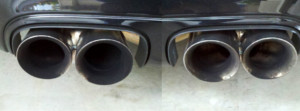 One of the potential early signs for significant engine problems is a mismatch in the sooty deposits inside the exhaust tailpipes. This clearly shows a difference in the running efficiency of one bank of cylinders versus the other and further investigation for the cause is necessary. A car with one black sooty tail pipe and one clean tail pipe is not a car to buy.
One of the potential early signs for significant engine problems is a mismatch in the sooty deposits inside the exhaust tailpipes. This clearly shows a difference in the running efficiency of one bank of cylinders versus the other and further investigation for the cause is necessary. A car with one black sooty tail pipe and one clean tail pipe is not a car to buy.
Cam to Crank Timing Deviation
Timing is everything: the opening and closing of valves, the piston rising and falling in the cylinder, fuel injection and a spark are required at precise times during an engine rotation.
The major moving parts are connected by chains and these ensure the relationship between those moving parts is maintained regardless of the rotational speed. The rotation is measured in degrees of a full circle. So, for example, at degree zero; piston 1 should be at the top of the cylinder and the intake and exhaust valves closed. This is known as top dead center or TDC.
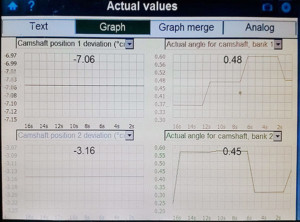 Naturally over time, the components supporting those timing chains will wear – the chain itself, guide rails, tensioners etc. will all wear and cause a deviation in the precise timing angles between camshafts and crankshaft. The engine management system is measuring the angles in every rotation and within a range of angles, can adjust the timing of fuel delivery and spark to compensate for wear changes. However, extended wear can produce an angle outside of the allowed deviation range and a fault condition will be set.
Naturally over time, the components supporting those timing chains will wear – the chain itself, guide rails, tensioners etc. will all wear and cause a deviation in the precise timing angles between camshafts and crankshaft. The engine management system is measuring the angles in every rotation and within a range of angles, can adjust the timing of fuel delivery and spark to compensate for wear changes. However, extended wear can produce an angle outside of the allowed deviation range and a fault condition will be set.
You need a clear picture of where the 996 you propose to buy, is in this wear process. A competent Porsche repair shop can tell you what the deviation angle between the cam and crank is during a used car inspection. This is a simple read from a diagnostic device and a clear indicator as to the health of the engine timing.
The change in angle will affect performance and is almost certainly not something you could pick up on during a test drive of an unfamiliar car. Replacing the chains, guides and tensioners to correct this problem is not an inexpensive proposition – it is however, relatively straightforward if your budget allows.
Potential Oil Leaks
There are some common areas where oil leaks occur. Most are easily fixed and are part of the normal wear and tear. One of the most common areas for an oil leak is the rear main seal. Again, see our common problems page for more information. Oil leaks should not be a barrier to purchase, but they should be considered in terms of the purchase price and the cost of the repair.
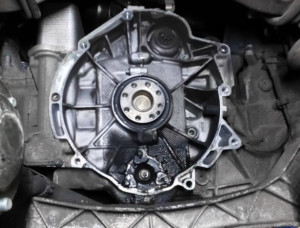 The leaking rear main seal on a 911 Carrera, requires removal of the transmission for access. On an automatic transmission car, the leaking seal is not doing too much other damage. However, on a manual car, oil leaking on to the clutch will cause significant damage and require replacement of the clutch components. This can get worse – a slipping clutch can damage the flywheel and also require its replacement. Flywheels are expensive.
The leaking rear main seal on a 911 Carrera, requires removal of the transmission for access. On an automatic transmission car, the leaking seal is not doing too much other damage. However, on a manual car, oil leaking on to the clutch will cause significant damage and require replacement of the clutch components. This can get worse – a slipping clutch can damage the flywheel and also require its replacement. Flywheels are expensive.
The leaking rear main seal can also be hiding other issues. Sometimes the seal will start to leak because of pressure in the crankcase – see common problems for more details.
Leaking oil used to just be seen as a annoying stain on the driveway and a minor fire hazard. However, modern cars feature electronic engine management systems that can potentially be severely damaged by oil ingress. What appears to be a minor oil leak could turn into an expensive electrical system repair.
Coolant Radiators and Air-Conditioning Condensers
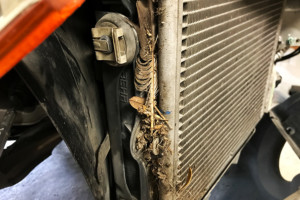 The design of the 911 has the placement of the coolant radiators and air-conditioning condensers low down in the front bumper. The position and open vent nature of the design leaves them, not only susceptible to stone impacts, but also to buildup of debris that gets stuck close to the radiator sides.
The design of the 911 has the placement of the coolant radiators and air-conditioning condensers low down in the front bumper. The position and open vent nature of the design leaves them, not only susceptible to stone impacts, but also to buildup of debris that gets stuck close to the radiator sides.
These front ducts need to be cleaned out regularly or protected by an aftermarket screen. The front bumper has to be removed to reach the radiators and most owners never do it.
Take a flash light and look closely to see whether the front air intakes are full of rotting leaves and debris when you inspect the 996 Carrera. Look closely, the debris will be around the sides of the radiators.
Damaged or corroded radiators and AC condensers cannot be repaired and must be replaced.
Brakes
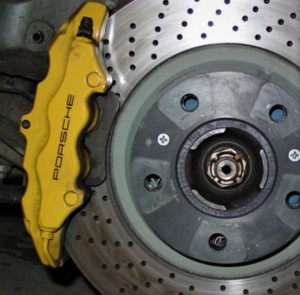 The brakes on the 996 Carrera are generally excellent. Brake pad material does degrade over time, so again, on low mileage examples check to see when the last brake service was performed. The brake fluid should be changed every few years regardless of mileage.
The brakes on the 996 Carrera are generally excellent. Brake pad material does degrade over time, so again, on low mileage examples check to see when the last brake service was performed. The brake fluid should be changed every few years regardless of mileage.
A complete brake service with pads, rotors and sensors can be quite expensive. So, if you’re buying from a used car vendor, look for new pads on old rotors. Both the pads and rotors should always be changed at the same time. Used car centers are famed for just replacing the pads and leaving on the old rotors. “The car has new brakes” – not if the rotors weren’t changed it doesn’t.
Worn rotors crack or disintegrate, which can be particularly unpleasant when driving! The 996 Carrera came with drilled rotors. Look carefully to see how clear the drill holes are and make sure there are not cracks between the drill holes. Cracks between the drill holes can lead to a much bigger crack and rotor failure very quickly under heavy braking.
Transmission & Clutch
The manual and automatic transmissions on the 996 are generally highly reliable. Both should change gear smoothly and without any hesitation. The auto transmission can be scanned for faults but rarely has issues. Fluid services can be performed on both transmissions and the duration of the time interval is quite high. Look for previous indications this has been done or understand where the car is in terms of time related fluid changes for the transmission. Typically, problems with the automatic transmission usually spell replacement – not cheap!
How long does a clutch last?
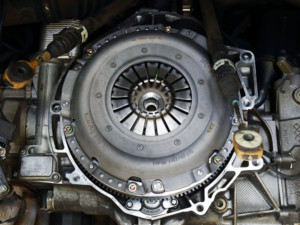 The answer depends on who is driving the car! We’ve seen customers destroy a clutch in 15K miles and we’ve also seen many that have more than 100K miles on them. Wear on the 996 clutch should be very noticeable. Engine revs will increase while the car does not accelerate. This is usually associated with a nasty burning smell. A slipping clutch spells trouble if not addressed immediately. There should also be no judder when the clutch is released. This could be a sign of oil on the clutch plate.
The answer depends on who is driving the car! We’ve seen customers destroy a clutch in 15K miles and we’ve also seen many that have more than 100K miles on them. Wear on the 996 clutch should be very noticeable. Engine revs will increase while the car does not accelerate. This is usually associated with a nasty burning smell. A slipping clutch spells trouble if not addressed immediately. There should also be no judder when the clutch is released. This could be a sign of oil on the clutch plate.
When the clutch slips it very quickly does damage to the flywheel. Replacing the flywheel on the 911 is simple during the clutch work, but typically adds $700 to the overall cost in parts alone! Check the used 996 you plan to buy for clutch replacement history and plan to have to do the work at some point in the future.
Suspension and Tires
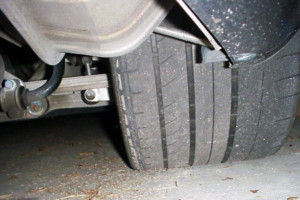 The suspension on the 911 is very solid. Naturally, over time wear can occur in plastic or rubber bushings that help to cushion the ride. Listen out for squeaks or clunks over bumps and check for leaks from the suspension struts.
The suspension on the 911 is very solid. Naturally, over time wear can occur in plastic or rubber bushings that help to cushion the ride. Listen out for squeaks or clunks over bumps and check for leaks from the suspension struts.
Worn suspension components will typically show up as uneven tire wear. Check the tires thoroughly for smooth wear patterns. In particular, take a good look at the inside of the rear tires. The rear camber setting and wear in the rear control arms on the 911 can often produce excessive inside shoulder wear.
Pay attention to the tire DOT date. This is the date the tires were manufactured and is expressed in two numbers. For example, a DOT of 2312 means the tire was produced in the 23rd week of 2012. You’ll want to see a date that is no more than 5 years earlier. Low mileage cars in particular have this problem – the tires do not experience wear because of the lack of mileage. However, tires have a shelf life and will degrade while they sit – lots of tread doesn’t always mean a healthy tire. A tire that is more than 5 years old could rapidly degrade or fail when you’re driving, despite the amount of tread remaining.
Convertible Top
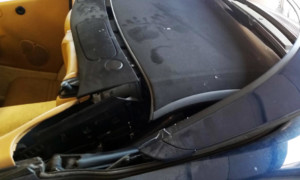 Make sure you spend time checking the operation of the roof to ensure it goes up and down smoothly. Many of the known problems with the opening & closing mechanism should have been resolved during the previous owner’s time. Most of the top issues are usually simple and inexpensive to fix, but can be annoying if you only discover them when you want to drop the top on your first sunny day.
Make sure you spend time checking the operation of the roof to ensure it goes up and down smoothly. Many of the known problems with the opening & closing mechanism should have been resolved during the previous owner’s time. Most of the top issues are usually simple and inexpensive to fix, but can be annoying if you only discover them when you want to drop the top on your first sunny day.
Porsche revised the mechanism that operates the top a few times during the life of the 996. Older original versions of the mechanism have parts that cannot be serviced. They need to be replaced with the entire revised system. Worth checking the history on the car to see if any work on the top has been recorded.
Importantly, look for signs of leaks from the roof into the cabin. Look behind the seats in particular. The rear roof drains can get blocked by leaves and debris over time. This results in rainwater dripping into an area of the cabin in which electronic control units are located. It is simple enough to keep the drains clear, but failing to do so can be an expensive and annoying oversight.
Twist or Stick?
The older 911 Carrera is a great car and can be serious fun. Don’t count on it going up in value quickly – you might have to wait a while. There are ways to give yourself a little protection from the known failures and there are also ways to add more fun.
Many of the parts from the later 997 can be made to work on the 996. The bumpers and engine covers can be swapped from one 996 to another – so you can update the look easily with a Turbo or Cup Car front bumper. There’s also still a good amount of aftermarket products available, such as exhaust or intakes, etc. Replacement lighting and LED headlights always brighten the look of this car too.
We think the 996 has been beaten up and under sold. Finding the right car is never simple, but with some luck and armed with the right information, you can pickup a bargain. 15 year old cars with reasonable mileage are available for less than 20% of what they cost originally!
We strongly recommend making friends at your local Independent Porsche repair shop before you buy.






